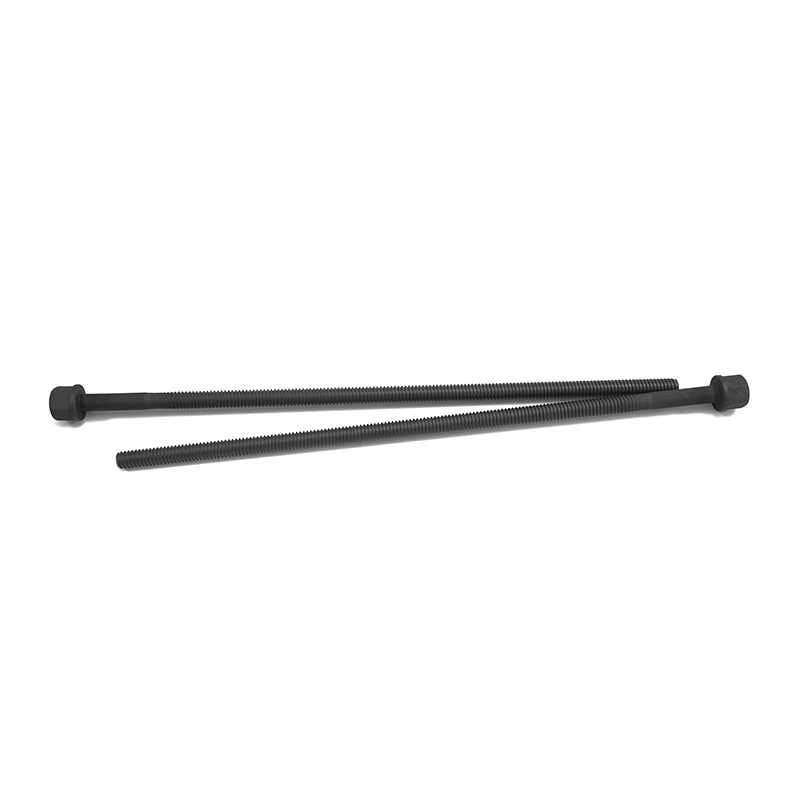The hex head screw rod plays a pivotal role in the mechanical operation of lifting systems, particularly in jacking mechanisms used across industrial, automotive, and civil engineering contexts. As a fundamental load-bearing and torque-transmitting component, the hex head screw rod must exhibit high standards of dimensional accuracy, thread integrity, and material performance under static and dynamic loads. This article delves into the structural design, material selection, manufacturing techniques, and mechanical behavior of hex head screw rods specifically engineered for jack systems, examining how they contribute to the controlled elevation and stabilization of heavy loads.
Content
- 1 1. Functional Role in Jacking Systems
- 2 2. Hex Head Geometry: Torque Transmission and Accessibility
- 3 3. Thread Profile and Pitch Considerations
- 4 4. Material Selection and Mechanical Properties
- 5 5. Dimensional Precision and Manufacturing
- 6 6. Applications in Engineering and Industry
- 7 7. Design Challenges and Engineering Considerations
1. Functional Role in Jacking Systems
In jacking devices—such as mechanical screw jacks, bottle jacks, and integrated lifting modules—the screw rod serves as the primary element that converts rotational motion into linear displacement. The hex head at the top allows for the application of torque via hand tools, powered drives, or actuators, while the threaded shaft transfers this torque into axial force, lifting or lowering a load with precision. The integrity of the screw rod directly influences the reliability, lifting capacity, and mechanical efficiency of the jack.
2. Hex Head Geometry: Torque Transmission and Accessibility
The hexagonal head, typically conforming to standardized dimensions such as DIN 933 or ANSI B18.2.1, facilitates uniform torque application using wrenches, sockets, or powered tools. Compared to square or slotted heads, the hex configuration offers:
-
Greater Contact Surface Area: This minimizes tool slippage under high torque.
-
Multi-Angle Access: The six-sided geometry allows tool engagement at 60° intervals, improving usability in confined environments.
-
Enhanced Load Distribution: It reduces the risk of localized stress concentrations that could lead to head rounding or material failure.
The size of the hex head is selected based on the torque requirements of the lifting system and must be proportionally matched to the diameter and pitch of the screw thread to prevent mechanical imbalance.
3. Thread Profile and Pitch Considerations
The screw thread’s profile and pitch dictate the mechanical advantage and lifting speed of the jack. For most jacking applications, the following threading parameters are typically optimized:
-
Acme or Trapezoidal Threads: These profiles offer broad contact surfaces for better load distribution and wear resistance.
-
Fine vs. Coarse Pitch: Fine threads allow for finer lifting control and higher load capacities but require more revolutions per unit distance. Coarse threads offer faster operation but may reduce mechanical efficiency under load.
-
Self-Locking Capability: Thread geometry is selected to ensure that back-driving does not occur under static load, enhancing safety.
Surface finish of the thread flanks is also critical, as poor finishes can increase friction, reduce lifting efficiency, and accelerate wear.

4. Material Selection and Mechanical Properties
Hex head screw rods for jacks are subject to compressive and torsional stresses, often in challenging operating environments. As such, the material selection must ensure both structural rigidity and fatigue resistance. Common materials include:
-
Medium Carbon Steel (e.g., C45 or 1045): Offers a balance of tensile strength and machinability.
-
Alloy Steel (e.g., 42CrMo4 or 4140): Provides enhanced yield strength, toughness, and fatigue performance, especially for high-load or repetitive-use applications.
-
Heat-Treated Variants: Quenching and tempering processes are often applied to improve surface hardness while maintaining core ductility.
-
Surface Treatments: Zinc plating, black oxide coating, or phosphate treatments provide corrosion resistance, particularly important in outdoor or marine applications.
Mechanical properties are typically specified in accordance with ISO or ASTM standards, with tensile strengths ranging from 800 MPa to over 1200 MPa depending on the load requirements.
5. Dimensional Precision and Manufacturing
Precision in thread pitch, shaft straightness, and head tolerances is essential to ensure proper engagement with mating components and smooth linear translation. Manufacturing steps may include:
-
Cold or Hot Forging of the Head: Ensures uniform grain structure and eliminates porosity at the hex interface.
-
Thread Rolling or Cutting: Thread rolling is preferred for its superior surface finish and fatigue resistance due to cold work hardening and fiber alignment.
-
CNC Machining: Used for finishing and achieving tight dimensional tolerances, especially for custom designs or high-performance assemblies.
-
Quality Control: Dimensional inspections, hardness testing, and torque capacity evaluations ensure consistency across production batches.
Advanced manufacturing also enables customization for non-standard jack systems, including asymmetric thread profiles, integrated retaining features, or anti-rotation flats.
6. Applications in Engineering and Industry
Hex head screw rods designed for jacks are widely employed in:
-
Vehicle Maintenance: As part of scissor jacks or bottle jacks, enabling safe lifting during tire replacement or underbody access.
-
Construction Equipment: In foundation leveling systems, shoring platforms, and temporary load-bearing setups.
-
Aerospace Ground Support: For adjustable work stands or mobile lifting units that require precise elevation control under dynamic loads.
-
Industrial Assembly Lines: Integrated into height-adjustable platforms or support fixtures requiring stable and repeatable vertical movement.
The robust nature of hex head screw rods makes them well suited for environments that demand reliability, load-bearing efficiency, and safety redundancy.
7. Design Challenges and Engineering Considerations
While simple in appearance, the engineering behind screw rods for jacks must account for:
-
Stress Concentration: Especially at the thread root and transition from head to shank.
-
Alignment Accuracy: Misalignment between the screw rod and load axis can result in bending stresses and premature failure.
-
Thermal Expansion: In applications involving temperature fluctuation, material selection must accommodate thermal dimensional changes without compromising fit or performance.
-
Lubrication and Friction: Adequate lubrication is critical to minimize thread wear and maintain consistent torque-to-thrust conversion efficiency.
Failure to address these considerations can lead to thread galling, surface pitting, or complete structural compromise under high-load conditions.

 English
English 中文简体
中文简体 Español
Español русский
русский عربى
عربى








